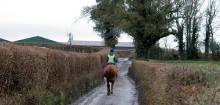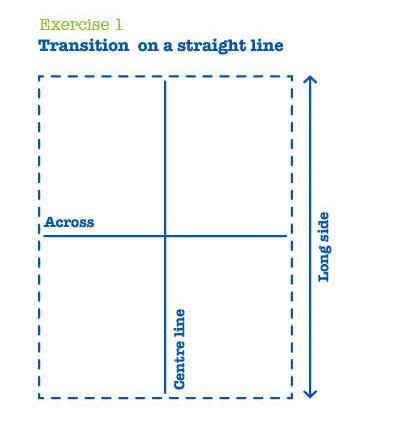
How to exercise your horse safely during the winter months
Keep your horse exercised during the cold, dark months this winter with our three quick-fire exercises – and learn how to focus a fresh, spooky horse.
Winter can be a tricky time to fit in riding, especially with its shorter days. But Stef Eardley, a British Horse Society coach and British Dressage trainer, says there are efficient and simple exercises you can do to keep your horse healthy and in good condition. Here’s her top three 20-minute training sessions – just remember to warm up your horse beforehand and perform each exercise on both reins.
Exercise one: Transition on a straight line

This exercise is a great way to check that your horse is responsive to your aids. The aim is for your horse to be straight through his body, equal between hand and leg, and responsive to your commands. This can be done in all three paces and include halt. Transitions can be ridden from one pace to another, in and out of halt or to vary stride length (for example, working trot to medium trot).
Just follow these steps:
- Begin by asking for a transition from walk to halt on the long side of the arena
- Once this is established, you can then ask for transitions from walk to trot and from trot to canter
- You can perform these transitions along the long side, down the centre line and across the arena. Transitions done away from the fence line are trickier because your horse will have to work harder to stay straight and you’ll have to concentrate more on how they start and finish the transition. They should be straight going into the transition, as well as coming out of it
- To up the difficulty level, you can ask for indirect transitions, for example from halt to trot and walk to canter
Exercise two: Canter circles

Canter circles will encourage your horse to improve their balance and engagement in canter and listen to your aids. It’s vital that the circles are the correct shape and that your turns and transitions are smooth. Changing the bend of the circles will also help to develop suppleness. Less experienced riders or horses can ride the 20m circles in trot and the 10m circles in walk to begin with.
Give it a go with these steps:
- Begin by cantering a 20m circle between B and E. Your horse should maintain a good rhythm and not over-bend through their body or fall in or out on the circle
- Once your canter circle is established, you can add in a transition to trot when you cross the centre line and then immediately perform a 10m circle the opposite way. Make sure your horse is on the correct bend during the changes in direction
- When you’ve completed your 10m circle, continue the 20m circle in canter
- To up the difficulty level, try adding a second 10m circle at the other end of the 20m circle
Exercise three: A square of poles

Introducing poles into your session will add an element of fun and give your horse something new to focus on. This exercise works on fine-tuning your riding skills and accuracy, and encourages suppleness, rhythm and balance in your horse.
Here’s how you can put it into action:
- Set out four poles in the shape of a 7m-wide square
- Ride large round the arena in trot. Once you’ve established a good rhythm, come across the diagonal and ride over the centre of the A poles, making sure that your horse stays straight, in balance and in an equal rhythm and speed
- Turn on a half-circle to then return across the other diagonal and ride over the centre of the B poles
- Then ride the half circle to return across the diagonal and ride back over the A poles in a figure of eight shape
- To make it extra challenging, trot over the poles and then ride the half circle in canter, before going back to trot to ride over the poles
Dealing with sharp horses in winter
Does your usually calm horse become spooky on a winter evening or struggle with pent-up energy during bad weather? Grand Prix dressage rider and trainer Kate Cowell shares her tips for staying safe and confident when riding your horse in winter.
Warm up your horse
Ride in a quarter sheet and try lunging your horse, first using a horse walker or doing some in-hand exercises before you ride. This will help your horse warm up their muscles, relax and get them thinking forwards.
Keep their minds busy
Avoid trotting aimlessly around the school. Mix it up with the following ideas:
Transitions: Kate recommends using a mix of direct transitions (from one pace to another, for example walk-trot) and transitions within a pace (for example, working trot-medium trot) to get your horse listening to you. Read these tips on how to ride better transitions from Charlie Hutton.
Stretching: Physical relaxation is key to keeping your horse focused and responsive to your aids, not on what’s going on around them. While you’ll have to work up to this, being able to stretch your horse in a longer frame, in all paces, can help to open up their spinal processes and engage their core and strengthen their top line.
Poles: Simply adding a positive diversion to capture your horse’s attention can help them forget about tension. These pole-work exercises are perfect because you can set out a mixture, suitable for riding in different paces, and start using them as soon as you get on.
Riding in wintry conditions
Winter can bring snow and ice, so how can you exercise your horse in these conditions safely?
It’s possible to ride on snow, but only if the snow isn’t balling up in your horse’s hooves – this can be dangerous and cause an injury or accident. Some riders find greasing the insides of their horse’s hooves prevents the snow from balling.
It’s always advisable to ride at a walk or trot over snow and stick to riding or leading your horse in-hand across fields where you know the ground is good underneath the snow.
Avoid riding on icy surfaces, especially untreated roads, which become slippery when icy. Grit walkways where possible and opt for riding in the arena or field on icy days if possible. However, make sure to check the surface first – schooling on hard, frozen ground could cause concussion in your horse's feet and frozen ruts may pose a trip hazard.
If you’re unsure about riding, exercise your horse in-hand, walking him or her over poles in the arena of paddock if it’s safe to do so.



